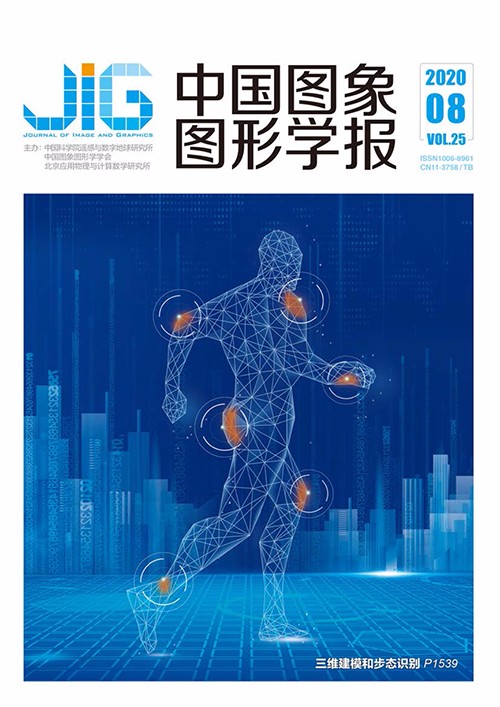
扩展点态卷积网络的点云分类分割模型
摘 要
目的 点态卷积网络用于点云分类分割任务时,由于点态卷积算子可直接处理点云数据,逐点提取局部特征向量,解决了结构化点云带来的维度剧增和信息丢失等问题。但是为了保持点云数据结构的一致性,点态卷积算子及卷积网络模型本身并不具有描述点云全局特征的结构,因此,对点态卷积网络模型进行扩展,扩展后的模型具有的全局特征是保证分类分割准确性的重要依据。方法 构造中心点放射模型来描述点云逐点相对于全局的几何约束关系,将其引入到点态卷积网络的特征拼接环节扩展特征向量,从而为点态卷积网络构建完善的局部—全局特征描述,用于点云数据的分类分割任务。首先,将点云视为由中心点以一定方向和距离放射到物体表面的点的集合,由中心点指向点云各点的放射矢量,其矢量大小确定了各点所存在的曲面和对于中心点的紧密程度,矢量方向描述了各点对于中心点的包围方向及存在的射线。进而由点云中的坐标信息得到点云的中心点,逐点计算放射矢量构造中心点放射模型,用以描述点云的全局特征。然后,利用点云数据的坐标信息来检索点的属性,确定卷积中参与特定点卷积运算的邻域,点态卷积算子遍历点云各点,输出逐点局部特征,进一步经多层点态卷积操作得到不同深度上的局部特征描述。最后,将中心点放射模型的全局特征和点态卷积的局部特征拼接,完成特征扩展,得到点态卷积网络的扩展模型。拼接后的局部—全局特征输入全连接层用于类标签预测,输入点态卷积层用于逐点标签预测。结果 在ModelNet40和S3DIS(Stanford large-scale 3D indoor spaces dataset)数据集上分别进行实验,验证模型的分类分割性能。在ModelNet40的分类实验中,与点态卷积网络相比,扩展后的网络模型在整体分类精度和类属分类精度上分别提高1.8%和3.5%,在S3DIS数据集的分割实验中,扩展后的点态卷积网络模型整体分割精度和,类属分割精度分别提高0.7%和2.2%。结论 引入的中心点放射模型可以有效获取点云数据的全局特征,扩展后的点态卷积网络模型实现了更优的分类和分割效果。
关键词
Extended pointwise convolution network model for point cloud classification and segmentation
Zhang Xinliang, Fu Chenlin, Zhao Yunji(School of Electrical Engineering and Automation, Henan Polytechnic Univercity, Jiaozuo 454000, China) Abstract
Objective A pointwise convolution network (PCN) has great potential for the classification and segmentation of point cloud data. The pointwise convolution operator in each layer directly functions on the point cloud data to generate the local feature vectors point-by-point. The PCN can solve the problems caused by dimension increase and information loss because of the avoidance of point data structuration. However, the structure of PCN is responsible for the consistent maintenance of the point cloud during the implementation of pointwise convolution. Consequently, the PCN has no constituent that can describe the global features of point cloud. The PCN essentially needs a characteristic expansion considering the global features in terms of classification and segmentation accuracies for the point cloud data. Method A so-called central point radiation model is proposed in this paper to pointwisely describe the global geometric properties. With the introduction of the radiation model into feature concatenation, the resultant extended PCN (EPCN) realizes a complete representation of local and global features for point cloud classification and segmentation. First, the point cloud in the central point radiation model is regarded as a set of projection point on the object surface by a radiation line from the central point. The amplitude of radiation vector determines the owner surface and tightness of each point around the central point, and the direction specifies the pointwise encircling direction and contributing radiation line. The central point is prescribed by the calculation of coordinate information in the point cloud, and the pointwise radiation vector is generated. Thus, the central point radiation model is constructed to describe global features. Second, the local feature description of the point cloud data at each depth is obtained through a multilayer pointwise convolution. The coordinates of the point cloud data provide an index for retrieving point attributes and determining the neighborhood points involved in the convolution of a concerned point. The pointwise convolution traverses all points in the point cloud and completely yields the pointwise local features. Finally, an EPCN is derived through the concatenation of the global features from the central point radiation model and the local features from the pointwise convolution. The complete feature description vector is adopted as the input of the fully connected layer of PCN for the category label prediction, and the input of the pointwise convolution layer is used for the label prediction point-by-point. Result The classification and segmentation performance of the proposed EPCN model are validated on the point cloud data sets of ModelNet40 and S3DIS(Stanford large-scale 3D indoor dataset), respectively. The EPCN classification on ModelNet40 leads to 1.8% and 3.5% increases in mean and m-class accuracies compared with the PCN. The EPCN segmentation on S3DIS provides 0.7% and 2.2% increases in s-mean and ms-class accuracies compared with the PCN. Conclusion Experimental results verify the effectiveness of the proposed central point radiation model for the global feature extraction of the point cloud data. The EPCN model provides an improved performance in terms of classification and segmentation.
Keywords
point cloud pointwise convolution central point radiation model classification segmentation feature extension
|



 中国图象图形学报 │ 京ICP备05080539号-4 │ 本系统由
中国图象图形学报 │ 京ICP备05080539号-4 │ 本系统由